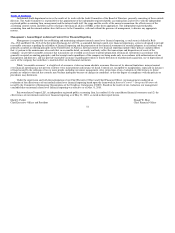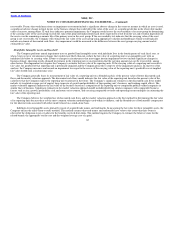Nike 2010 Annual Report Download - page 66
Download and view the complete annual report
Please find page 66 of the 2010 Nike annual report below. You can navigate through the pages in the report by either clicking on the pages listed below, or by using the keyword search tool below to find specific information within the annual report.
Table of Contents NIKE, INC.
NOTES TO CONSOLIDATED FINANCIAL STATEMENTS — (Continued)
Foreign Currency Translation and Foreign Currency Transactions
Adjustments resulting from translating foreign functional currency financial statements into U.S. dollars are included in the foreign currency
translation adjustment, a component of accumulated other comprehensive income in shareholders’ equity.
The Company’s global subsidiaries have various assets and liabilities, primarily receivables and payables, that are denominated in currencies other
than their functional currency. These balance sheet items are subject to remeasurement, the impact of which is recorded in other (income) expense, net,
within our consolidated statement of income.
Accounting for Derivatives and Hedging Activities
The Company uses derivative financial instruments to limit exposure to changes in foreign currency exchange rates and interest rates. All derivatives
are recorded at fair value on the balance sheet and changes in the fair value of derivative financial instruments are either recognized in other comprehensive
income (a component of shareholders’ equity), debt or net income depending on the nature of the underlying exposure, whether the derivative is formally
designated as a hedge, and, if designated, the extent to which the hedge is effective. The Company classifies the cash flows at settlement from derivatives in
the same category as the cash flows from the related hedged items. For undesignated hedges and designated cash flow hedges, this is within the cash
provided by operations component of the consolidated statement of cash flows. For designated net investment hedges, this is generally within the cash used
by investing activities component of the cash flow statement. As our fair value hedges are receive−fixed, pay−variable interest rate swaps, the cash flows
associated with these derivative instruments are periodic interest payments while the swaps are outstanding, which are reflected in net income within the
cash provided by operations component of the cash flow statement.
See Note 18 — Risk Management and Derivatives for more information on the Company’s risk management program and derivatives.
Stock−Based Compensation
The Company estimates the fair value of options granted under the NIKE, Inc. 1990 Stock Incentive Plan (the “1990 Plan”) and employees’ purchase
rights under the Employee Stock Purchase Plans (“ESPPs”) using the Black−Scholes option pricing model. The Company recognizes this fair value, net of
estimated forfeitures, as selling and administrative expense in the consolidated statements of income over the vesting period using the straight−line method.
See Note 11 — Common Stock and Stock−Based Compensation for more information on the Company’s stock programs.
Income Taxes
The Company accounts for income taxes using the asset and liability method. This approach requires the recognition of deferred tax assets and
liabilities for the expected future tax consequences of temporary differences between the carrying amounts and the tax basis of assets and liabilities. United
States income taxes are provided currently on financial statement earnings of non−U.S. subsidiaries that are expected to be repatriated. The Company
determines annually the amount of undistributed non−U.S. earnings to invest indefinitely in its non−U.S. operations. The Company recognizes interest and
penalties related to income tax matters in income tax expense.
63
























